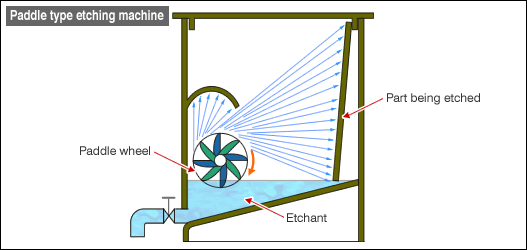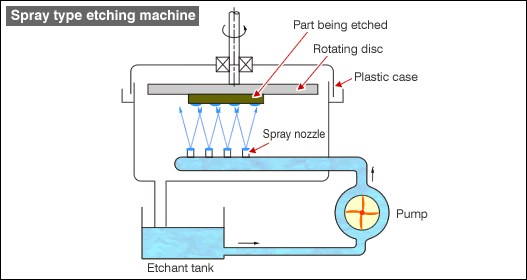#019 Chemical Etching - Chemical Blanking
Chemical blanking is used for parts that are otherwise typically produced by mechanical blanking presses from thin plates and foil material. With mechanical presses, vibrations, backlash, and part distortion will make smaller parts difficult to produce. Chemical blanking becomes a favorable solution in such a case.
(1) Process steps
Chemical blanking employs the following four steps.
a) Pre-process
Material cleaning - Metal surface is cleaned by degreasing, pickling and grinding.
b) Masking
Metal portion not to be removed by etching is covered with chemical resistant coating. For extra precise applications, photo-resist material is used.
c) Through-material etching
Since the material is to be penetrated through, etching is applied from both sides simultaneously.
d) Post-process
Removal of the resist material, and washing off etchant. If the resist material is non water soluble, organic solvents are used.
(2) Through-material etching
There are two application methods: Immersion type and Spray type. With the immersion type, the part is immersed in the corrosive liquid, and the liquid is constantly stirred. Air injection is the widely used stirring method.

The spray method of etching employs specially designed etching machines. Spray type machine has nozzle(s) that spray the etchant, and Paddle type has a rotating wheel with paddles that spray the etchant. Both types are made in vertical and horizontal configurations, as well as single sided etching and dual side etching types.

- Environmental conservation
- Hot Dipping
- Anodic Oxidation Process
- Anodic oxidation treatment
- Anodizing
- Corrosion - Corrosion Protection
- Electroless Plating
- Electroplating
- Heat treating
- Hydrogen embrittlement
- Metal cleaning
- Metal etching
- Painting
- Special paints
- Surface Treatment
- Surface-treated steel sheets
- Thermal Spraying



